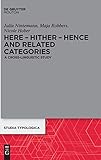Here – Hither – Hence and Related Categories : A Cross-linguistic Study / Julia Nintemann, Maja Robbers, Nicole Hober.
Material type: TextSeries: Studia Typologica [STTYP] : Beihefte / Supplements STUF - Sprachtypologie und Universalienforschung / Language Typology and Universals ; 26Publisher: Berlin ; Boston : De Gruyter Mouton, [2020]Copyright date: ©2020Description: 1 online resource (XXVIII, 540 p.) : 7 Appendices = S. 425-527 (102 Seiten Tabellen)Content type:
TextSeries: Studia Typologica [STTYP] : Beihefte / Supplements STUF - Sprachtypologie und Universalienforschung / Language Typology and Universals ; 26Publisher: Berlin ; Boston : De Gruyter Mouton, [2020]Copyright date: ©2020Description: 1 online resource (XXVIII, 540 p.) : 7 Appendices = S. 425-527 (102 Seiten Tabellen)Content type: - 9783110672442
- 9783110672725
- 9783110672640
- 415/.9 23
- P241 .N56 2020
- online - DeGruyter
- Issued also in print.
| Item type | Current library | Call number | URL | Status | Notes | Barcode | |
|---|---|---|---|---|---|---|---|
 eBook
eBook
|
Biblioteca "Angelicum" Pont. Univ. S.Tommaso d'Aquino Nuvola online | online - DeGruyter (Browse shelf(Opens below)) | Online access | Not for loan (Accesso limitato) | Accesso per gli utenti autorizzati / Access for authorized users | (dgr)9783110672640 |
Browsing Biblioteca "Angelicum" Pont. Univ. S.Tommaso d'Aquino shelves, Shelving location: Nuvola online Close shelf browser (Hides shelf browser)
Frontmatter -- Preface and Acknowledgments -- Contents -- List of Abbreviations -- List of Figures -- List of Maps -- List of Schemes -- List of Tables -- 1 Introduction -- 2 Formal relations of SI and SDD paradigms -- 3 The qualitative side of syncretism -- 4 The quantitative side of syncretism -- 5 Complexity -- 6 Further qualitative aspects of SIs and SDDs -- 7 Conclusions -- References -- Appendix I: Africa -- Appendix II: The Americas -- Appendix III: Asia -- Appendix IV: Europe -- Appendix V: Oceania -- Appendix VI: Overview of the distribution of patterns over the five macro areas -- Appendix VII: Calculation on how often languages employ the same pattern in the SDDs as in the SIs -- Index of Authors -- Index of Languages -- Index of Subjects
restricted access online access with authorization star
http://purl.org/coar/access_right/c_16ec
As a follow-up study to the global comparison of spatial interrogatives (Studia Typologica 20), the present book examines the spatial declarative counterparts which are provided by the expression class of spatial deictic adverbs. In a functionally motivated typological approach, equivalents of Early Modern English here – hither – hence and there – thither – thence are identified across a sample of 250 languages from all macro-areas. These are also quantitatively assessed to extrapolate areal and global trends of coding patterns. The formal relationships between spatial interrogative and spatial declarative paradigms are analyzed with a focus on the syncretism of categories and of individual cells. Qualitative discussions of patterns precede in-depth treatments of problematic cases and other relevant issues related to the research topic.The quantitative results strongly point to areal linguistic trends concerning the distribution of distinct and non-distinct coding of the three spatial relations Place, Goal, and Source. Additional aspects such as quantitative evaluations of constructional complexity are addressed subsequently.
Issued also in print.
Mode of access: Internet via World Wide Web.
In English.
Description based on online resource; title from PDF title page (publisher's Web site, viewed 25. Jun 2024)









